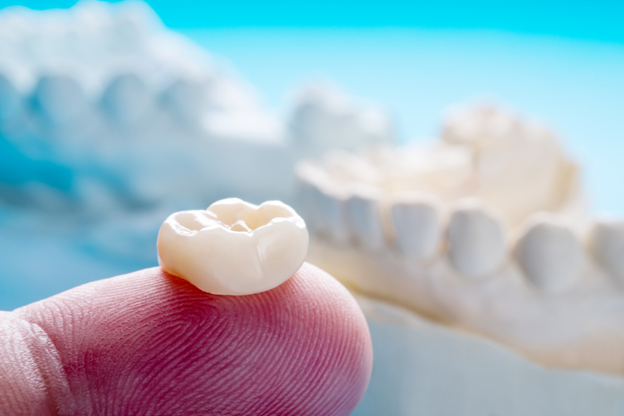Introduction
Dental crowns are one of the most common and effective solutions in modern dentistry for restoring damaged or decayed teeth. They are custom-made “caps” that fit over a tooth, providing both cosmetic and functional benefits. However, there are a lot of misconceptions surrounding dental crowns. Many people are unsure about what they are, how they work, and what the process involves.
In this blog, we’ll explore some common myths about dental crowns and set the record straight with the facts.
Myth #1: Dental Crowns Are Only for Cosmetic Purposes
Fact: While dental crowns do enhance the appearance of a tooth, they are primarily used for functional reasons. Crowns are often necessary when a tooth is severely damaged or decayed, making it weak or susceptible to further damage.
Crowns can also be used to restore a tooth that has undergone a root canal treatment. In these cases, the tooth is typically hollowed out and requires a crown to protect it from breaking or wearing down. Additionally, crowns can restore a tooth’s function by enabling it to withstand normal biting and chewing pressure.
Myth #2: Dental Crowns Are Painful
Fact: The procedure for placing a dental crown is not painful. In fact, most patients report minimal discomfort. The process begins with a local anesthetic to numb the tooth and surrounding area, ensuring the patient is comfortable throughout the procedure.
While there may be some mild sensitivity after the crown is placed, it usually resolves within a few days. It’s important to follow your dentist’s instructions for post-procedure care to minimize any discomfort. In some cases, if the crown does cause discomfort, it could be due to an ill-fitting crown or another issue, in which case your dentist can easily correct it.
Myth #3: Dental Crowns Don’t Look Natural
Fact: Dental crowns can be made from a variety of materials, including porcelain, ceramic, or metal alloys. Porcelain and ceramic crowns, in particular, are designed to mimic the appearance of natural teeth. They are highly durable and can be color-matched to the shade of your natural teeth, making them almost indistinguishable from surrounding teeth.
If you’re concerned about the appearance of your crown, speak with your dentist about using tooth-colored materials. With advancements in dental technology, crowns can now be made to look incredibly realistic, blending seamlessly with your natural smile.
Myth #4: Dental Crowns Only Last a Few Years
Fact: Dental crowns are durable and can last for many years, often between 10 to 15 years or longer with proper care. The longevity of a crown depends on several factors, including the material used, your oral hygiene habits, and your eating habits.
Crowns made from materials like porcelain or ceramic are particularly strong, and with good care (such as brushing and flossing regularly and visiting your dentist for check-ups), your crown can last a long time. However, if you grind your teeth, bite your nails, or have other habits that stress your crown, it could wear down more quickly.
It’s also important to note that the tooth beneath the crown may need attention over time, especially if it develops decay or other issues. Regular dental visits will ensure your crown remains in good condition.
Myth #5: The Crown Procedure Takes a Long Time
Fact: The procedure for placing a dental crown is usually completed in two visits. During the first visit, your dentist will examine the tooth, take X-rays if needed, and prepare the tooth by removing any damaged or decayed tissue. An impression of the tooth will be taken to create a custom crown. In the meantime, a temporary crown will be placed to protect the tooth.
At the second visit, the custom-made crown will be placed, adjusted for proper fit, and cemented into place. While it might take some time for the crown to be fabricated in a lab, the overall process of getting a crown is relatively quick and efficient.
Some dental offices even offer same-day crowns using advanced technology, allowing you to get your final crown during a single visit.
Myth #6: Dental Crowns Are Only Necessary for Older People
Fact: Dental crowns are needed by individuals of all ages, not just older adults. While crowns are often associated with aging teeth that may have worn down over time, they are also used to repair teeth that have been damaged due to injury, decay, or even certain habits like teeth grinding.
For younger patients, dental crowns may be necessary after a root canal, severe cavities, or trauma to a tooth. In fact, dentists may recommend crowns to restore the function and appearance of a tooth at any age, depending on the condition of the tooth and the patient’s needs.
Myth #7: Crowns Are Expensive and Not Covered by Insurance
Fact: The cost of dental crowns can vary depending on the material used, the dentist’s location, and the complexity of the procedure. However, dental insurance often covers a portion of the cost of crowns, especially if the crown is being placed for functional reasons (e.g., after a root canal or to restore a damaged tooth).
If you’re concerned about the cost, speak with your dentist about payment options or financing plans that may be available. Many dental offices offer flexible payment plans to help make dental crowns more affordable.
Myth #8: Getting a Dental Crown Is a Long and Complicated Process
Fact: The dental crown procedure is not as long or complicated as many people believe. With modern dental technologies, the procedure is quick and efficient. While it typically requires two visits, some dental offices can create and place a crown in just one visit using CAD/CAM (computer-aided design/computer-aided manufacturing) technology.
This technology allows for precise measurements and the creation of a custom crown right in the office, saving you time and effort. Additionally, advancements in sedation and local anesthesia make the procedure virtually pain-free.
Myth #9: Crowns Are Only for Teeth That Are Extremely Damaged
Fact: Dental crowns can be used for a variety of purposes, not just to repair severely damaged teeth. In addition to restoring teeth that have been fractured, cracked, or weakened by cavities, crowns are also used to:
- Cover and protect a tooth after a root canal
- Improve the appearance of a misshapen or discolored tooth
- Support a dental bridge or other restorative appliances
Crowns are versatile and can be a solution to many common dental problems, even if the tooth isn’t completely damaged.
Conclusion
Dental crowns are an effective and versatile solution for restoring damaged or decayed teeth, offering both cosmetic and functional benefits. By debunking these common myths, it’s clear that crowns are not only a practical treatment option but also an accessible one for many patients.
If you are considering a dental crown or have questions about whether it is the right treatment for you, consult with your dentist. With their help, you can restore the function and appearance of your smile with confidence and ease.
Consult us today at smiles and sculpt for expert guidance!


